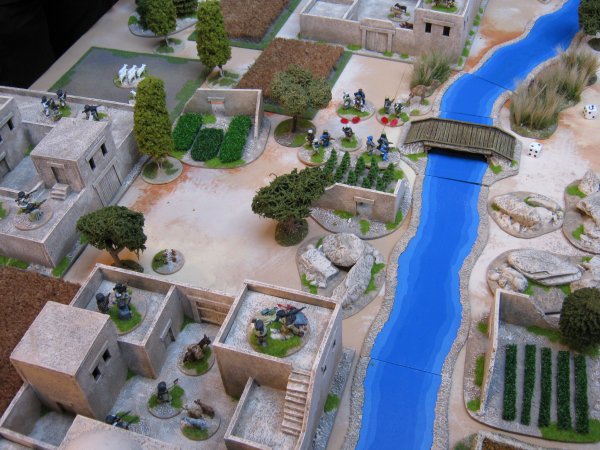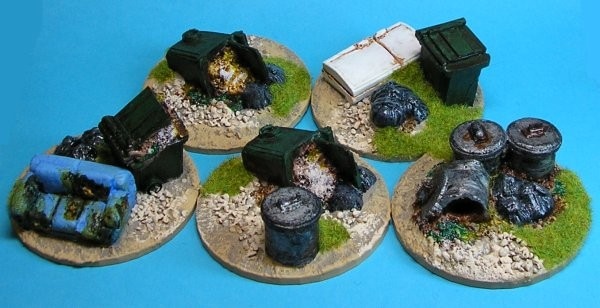|
Adapting Crossfire for Modern Combat
There's not much wrong with Crossfire as far as I'm concerned so I've only made a few small changes to make it more suitable for modern combat situations. Basing regular troops
I have reduced the scale of the encounters for modern games so that stands of regular, trained troops represent a fire team and not a squad. I base regulars in fours both for aesthetic reasons and because I give a fire team 4 dice for shooting. Two fire teams and a base of support weapons (two figures, 4 dice) make a section/squad and three sections/squads make a platoon. A platoon will have a command stand and possibly another support weapon such as a machine gun or mortar and sometimes an AFV for support. If you're familiar with WWII Crossfire you will realise that a platoon now uses roughly the same number and type of infantry stands as a company does in the standard rules and a platoon is now the basic operating force that a player controls. A section/squad may have a separate command figure represented similar to a PC but generally I assume the section leader is part of one of the fire teams. Leader figures may add a bonus to rallying but not to close combat and are not needed for movement or command and control purposes. Modern troops may move freely as fire teams without needing to be in LOS of a command figure thanks to modern communications technology and generally good levels of tactical awareness and training. They may also combine fire on a target so long as they are from the same section. It is not necessary for individual bases to be within LOS of each other, so long as they can see the chosen target group fire may take place. Basing insurgents
These are based and organised as normal Crossfire forces; three bases of three figures and a single command figure make a 'platoon' and three platoons make a 'company'. Each 'company' has attached support and transport assets and a 'company command' stand. Feel free to substitute your own terminology for 'platoon' and 'company' depending on the army you are modelling; cells, groups, families, tribes etc. A base of three insurgents receive 3 shooting dice and a support weapon such as a machine gun will have 4 dice as per the standard crossfire rules. Individual platoon leaders may only add bonuses to rallying and not close combat but a company commander/warlord has bodyguards and may add their weight to melee as a normal company commander does. Individual platoon commanders may be used to set up crossfires. Vehicles
I allow all vehicles unlimited movement in my Crossfire games. A moving vehicle must follow a straight line as a move action. Getting around corners therefore takes a couple of moves which simulates the vehicle slowing and becoming momentarily more at risk from enemy fire. Armoured vehicles are immune from small arms fire, non armoured vehicles such as technicals are treated as a normal infantry base. Cover
Because the number of figures a base represents has decreased I have introduced a lot more smaller scenery features that stands may shelter behind rather than occupying such as wrecked cars, low walls, urban detritus and stacks of market goods. These features don't block LOS for firing but if the line from shooter to target crosses one or more of them the shooter loses a dice from their total. These features do not interfere with movement and a stand may choose to halt at one of them or not as the controlling player wishes. Civilians
A base of civilian figures represents some of the local inhabitants and regular troops may not fire through them. They may spot through them for indirect weapons however. Insurgents may ignore them for shooting, moving and sighting purposes. Shooting
Shooting is carried out as in normal Crossfire with one exception. Irregular forces fighting regular forces cannot kill a stand with two successive suppression results, they must score a kill result (three hits) to actually kill them. |
Modern Booby trap/IED markers for Crossfire
In many modern theatres of operations troops face the constant threat of booby traps and bombs. Some are left by the side of the road disguised as innocuous items and some are strapped to the bodies of suicide bombers who can mingle with a crowd of civilians, remaining hidden until they launch their attack. One way to model these surprise attacks in Crossfire is to treat them as snipers and have the Insurgents player place a marker on a map or hidden on the table. This works well enough as far as causing damage goes but it tends to be a very one-sided affair with the Insurgents' opponent having no chance to avoid it. Often there are warning signs around that a bomb has been placed or an attack is imminent that well trained troops can pick up on, and respond to, to avoid the danger. An IED by the road can be spotted, civilian behaviour can alert troops to booby trap positions or the presence of hidden Insurgents.
To model this on the tabletop I have made several debris/trash markers (15 in all) that can be placed around the table. Most will just be what they appear to be but maybe one or two, depending on the scenario, will conceal bombs. The Insurgents player will know which and his opponent will be able to see potential trouble spots and act accordingly. Placing the markers in strategic places the Insurgents player can attempt to force his opponent to take a longer route than they had intended in order to avoid them or he can add apparent importance to areas of the table.
The other player may attempt to neutralise the possible danger by using an action to check a debris marker that is in Line of Sight of one of his troop or command stands. The player rolls D6 and neutralises the threat (discovers a bomb or ensures there isn't one) on a roll of 4+. Veterans add +1 to their roll. Green add -1 to their roll A failure loses the initiative. All the models for my debris markers are resin scenery pieces from Black Cat Bases.
|
















